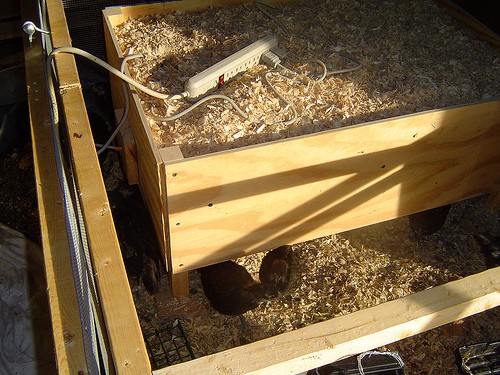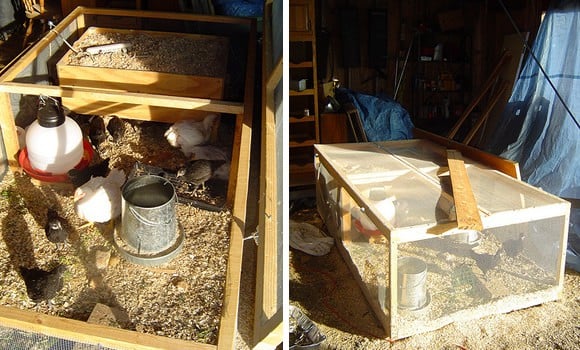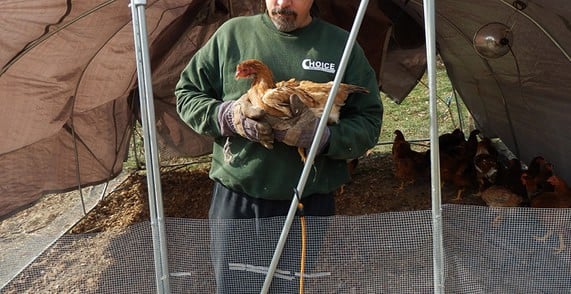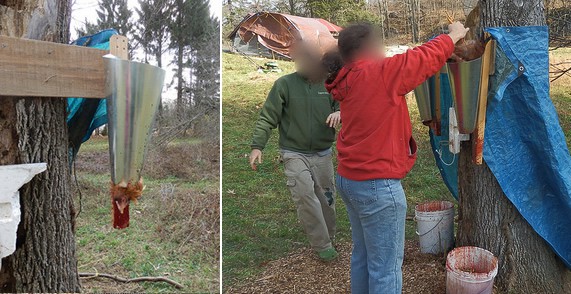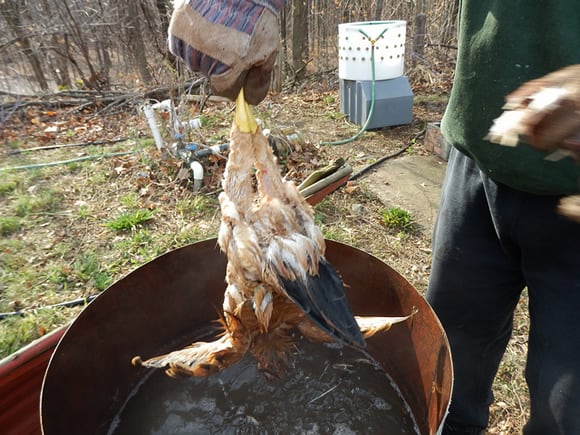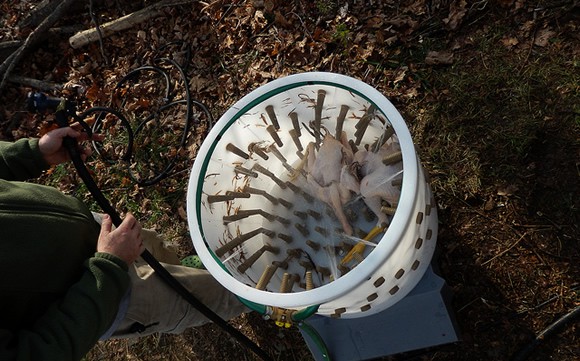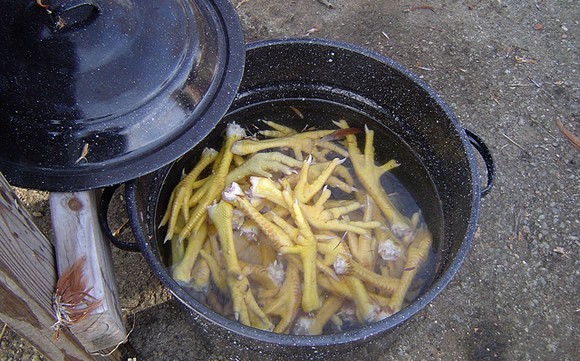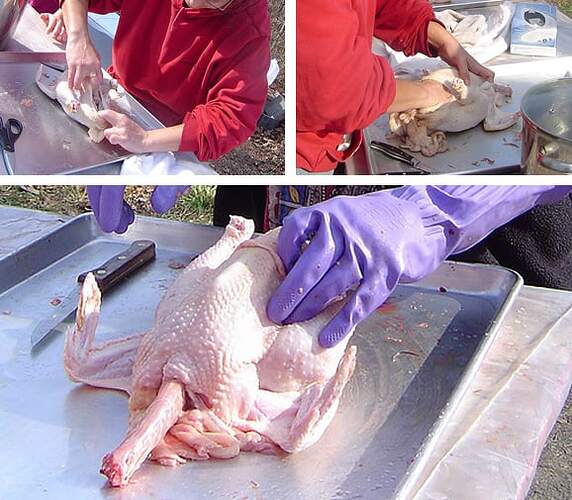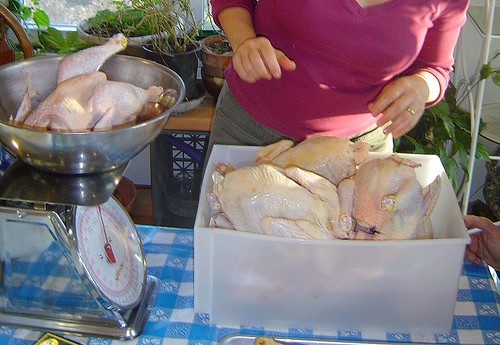Each month seems to witness the arrival of yet another article, documentary, or exposé about the highly questionable practices used by the Factory Food Industry. In pursuit of profit, methods of food production that would seem unthinkable are evidently quite commonplace (e.g., the recent “Pink Slime” revelations with regard to mass-produced ground beef – “Yeah, bro, give me some extra ammonia in my burger, okay?!”).
To the extent possible, My friends and I are undertaking to consume only animal protein that is raised naturally. We buy local. We buy organic. We buy free-range/pastured/etc. And when we can, we raise our own. (Although this article is about broiler chickens, I also have friends raising goats for meat.)
Broiler chickens are an option for folks like us. It doesn’t take 30 acres of land and huge infrastructure costs to raise several dozen birds, and out where we live in the Hudson Valley there aren’t any benighted Homeowners Associations to interfere. Last summer-into-fall, some friends (we’ll call them T&S) bought and raised 50 broiler chickens with the understanding that four families in our circle would split the cost and share in the harvest. This article is about the particulars of that experience.
First I must give thanks and credit to T&S, who laid out the money in advance, fed and watered the little chicks, built the hoop-coop in which the birds lived until harvest day, and finally did all the research regarding how to actually turn the live birds into freezer chickens (a considerable task unto itself). All of the material here that isn’t about my experience of harvest day (I never met the birds until that day) comes straight from S’s mouth.
Raising the Broilers
Getting Your Chicks
It is not difficult to procure broiler chicks. Do a quick Google search, or check your local Agway or farm supply store. Hatcheries offer a "hatch date" so you can time delivery to the day. Don’t underestimate the entertainment value of getting a call from your local Post Office asking you to come down and pick up your chicks (which you may be lucky enough to hear peeping away in the background) -– especially if you don’t live in a rural area.
In our experience the cost per chick was about US$2 for a shipment of 50 birds. Larger lots means less cost-per-bird, and if you order a mainstream/industrial breed (e.g., Cornish Rocks) the cost will be less. T&S decided not to go with Cornish Rocks since they grow so quickly and tend to have health issues. (They get so top-heavy with breast meat, they have a hard time standing upright, and after a certain point – 10 weeks, give or take – their hearts may begin to give out). T&S raised Red Broilers, which are slower-growing. Some breeds are good foragers (good if you’re going to free-range them during the day), and some are less so (good if you plan to keep them confined). The web is your friend and with a little research you will figure out which breed suits your setup and which aligns best with your overall purpose/plan.
Brooding
So, you have your chicks. They must be kept warm and dry until they have had a chance to grow their feathers. There are any number of brooder methods – again, check the Web – but T&S chose to build what is called a "hover brooder." Here is a picture:
You can find plans for a hover brooder on the Net. S liked this variety of brooder because the chicks huddle underneath it for warmth just like they would under a mother hen. But your brooder can be as simple as several powerful lights with reflectors hanging down near the floor. You can brood your chicks in the garage, or the basement, or a shed; anywhere they are protected from wetness and drafts is fine. T&S brooded theirs in the basement, where it was convenient to visit with and check up on the chicks.
You may lose a few chicks in the first week after receiving them due to the stress of shipping (they lost two out of 50). Within that first week, the chicks begin to put on weight, and feathers start to come in within days. The more space each chick has in the brooder, the less stress they have from crowding and the more they will ambulate (remember, active birds are healthy birds). You can also keep them in the brooder longer (despite their ever-growing size) if you have a brooder larger than is strictly necessary. This would be useful here when spring comes late to the Hudson Valley and we want to keep them indoors until the weather improves, though that was not the case this year
Here is a picture of T&S’s brooding pen (the hover brooder is at the far end):
The covering on the pen is ¼ inch hardware cloth, which will keep out all predators including rats, which cannot be said of chicken wire. T&S kept their chicks in the pen for about four weeks. They slowly weaned them off the heat lamps so that the environment outside would not come as a shock to them. Once the birds are ready, you can transfer them to their outdoor location, whether that is a coop, chicken tractor, or some other setup.
Feed
Keeping your chickens fed and watered is pretty straightforward. There are mechanical feeders and waterers, which you keep topped off so the food/water is dispensed as needed. Each person will need to make certain choices about what to feed their chickens. Organic feed? Standard-issue agricultural-store feed (i.e., with vitamins included), feed enhanced with antibiotics, etc. T&S gave their chicks a special high-protein feed to help them grow quickly, and fed them a mainstream vitamin-enhanced feed plus cracked grains as a treat. You will also need to get your chickens grit to fill their gizzard (T&S bought ground-up granite, but there are other options).
Medications
This is another individual decision that each chicken-raiser must make. Diseases such as cocodiasis (a microbe that lives in the dirt, causing eventually-fatal diarrhea in chickens) can decimate a flock. But according to S’s research, this is mainly a problem with large-scale operations – and since there would not be contact or cross-contamination with any other flocks, T&S decided to forgo prophylaxis for any disease, and have had no trouble thus far.
To Maturity/Harvest
The birds live in a predator-proof enclosure of some sort. S used combined fencing and hardware cloth (sunk into the ground to a depth of several inches to discourage burrowers), plus electric fence to turn away dogs/foxes/coyotes. Finally, he threw deer netting over the top of the open area of the hoop-house-type enclosure to keep raptors from being a problem.
Time from maturity to harvest depends on the breed. Cornish Rocks will be ready in 6-12 weeks (the longer the wait, the higher the attrition from their steep weight gain – 7 to 8 weeks to harvest is most common). Red Broilers run 10-12 weeks to maturity. Of course, you can harvest earlier; you just get a smaller bird.
The Harvest
(nb: Much of the following is a recapitulation of a post I made on the Definitive Permaculture thread. It contains graphic descriptions of the chicken slaughter, and the related photos are rather graphic where necessary.)
We met on Friday night to go over some of the logistics involved for the harvest Sunday. We thought we would have as many as seven people to handle the harvest, but as it turned out, we were only five (more on the numbers later). T&S shared the overall plan they had worked out, and we all watched some YouTube videos showing how it was done. The best was a short video of Joel Salatin, who demonstrated the process of dressing the carcass (removing organs, etc.) that he uses when harvesting birds for his customers. (He performed the whole operation in about two minutes, and that was slowed down so that he could point out this and that. He could probably do an entire bird in ~ 30 seconds. But he's had a wee bit of practice.)
We gathered on Sunday at around 8:30 a.m. After S and I got the propane burner going to heat the scald-water (same as the sort used to deep-fry Thanksgiving turkeys), he walked me through the stations they had set up.
STATION 1: the hoop-coop
Forty-eight birds were sequestered behind tarps and chicken-wire (surrounded by a triple-wire electric fence to keep off the coyotes, foxes, raccoons, fisher-cats, etc. who might fancy a tasty night-time snack). The step here was simple: Two people enter the coop, each grabs up a bird, and they head for Station 2. (This became more difficult as the day wore on and the flock grew smaller. More room to run = harder-to-catch birds. Also, the birds that were left tended to be the ones who were quicker or more wary of people = harder-to-catch birds.)
STATION 2: the killing cones
I first became aware of this method during the 2008 presidential election when Sarah Palin was interviewed (unwittingly, I believe) with a killing-cone in the background, in which a turkey was bled out while she answered questions from the reporter. S basically cut pieces of construction flashing perhaps two feet tall and two feet wide. These are curled around and fastened to themselves to yield a conical shape, and then nailed to a crossbar that was nailed to a tree at approximately 5' high, with the narrow end of the cone down.
The birds go into the cones head-down (the head hangs out of the bottom of the cone). The cone prevents them from struggling too much and makes a clean, quick killing stroke much easier. Below each cone was a 5-gallon plastic bucket partially filled with wood chips to collect/absorb the blood. We had a stainless steel knife of exquisite sharpness hanging on a loop between the cones.
With live chicken in hand, and heading to the cones, I'd stroke the neck with my (gloved) finger and quietly say "hush" or "shuu, shuuu" to calm them. Breathing deeply and rhythmically also seemed to work. In the 30 second trip between the coop and the cone, they quieted. Something in that 30 seconds made me feel the need to be there and witnessing until life -- which I took -- had gone.
To kill the chicken, one gently grasps its head and turns it to one side. Just to the rear of the eye and below the beak is the curve of the "jaw" (which is really the edge of the skull). The cut happens across the neck -- I preferred to cut from the side of the neck towards the center -- and severs the artery. Although the skin is delicate, the cut needs to be deep enough to hit the artery. It took a firm, but not forceful, hand, in my estimation. There is an immediate spurt of blood. Within seconds, the chickens eyes generally begin to close, and according to the "experts" this is when the bird loses consciousness and feels nothing further. (Some birds make a squawk at this point, but most do not.) There is about a 15-20 second lull while the body goes limp.
The heart continues to pump blood out, but in pulses, not spurts. Then there is anywhere from 15 seconds to a full minute of activity, ranging from kicking legs, to the neck curling or swaying back and forth, to the wings rattling inside the cone, to the eyes opening up (although I didn't see any awareness in those eyes), to all of the above. Then this gradually fades away until the body relaxes completely. (On a few occasions, I touched my hand to the side of the neck near the end of this latter stage -- you can feel a tension and a sort of vibration in the body. (That would be a real vibration, not a so-called "vibe"). This fades, fades, fades, and the end of this tension signals the ultimate death of the chicken, at which time it can be removed from the cone and taken to the next station.
Station 2 was by far the most intense and emotional for all of us who took part. It is the moment of the REAL: This is what being a carnivore means. You take the life of an animal and that vitality feeds your own. It's bloody. There is no "nicing" your way around this moment. In my opinion, if you try to rationalize your way through, it you've missed the whole meaning, along with the beauty of it.
Our entire day took six hours, but it never became dull or humdrum. The several minutes spent standing in front of the cones during each 10-minute cycle kept it intense. I felt that not to watch would have been disrespectful. We could have set it up so that I merely walked back and forth from coop to cone, cut bird, left to go grab another chicken -- and had a runner waiting for the cut bird to die and then carry it to the dunk. But there was no way I could do that.
STATION 3: the scalding pot
For what it is worth, as soon as the chickens came back out of the cone, I didn't pay them any special regard. As I walked toward the dunk/pluck/gut area, I pretty much was watching the folks there do their thing -- or looking around at the surrounding woods and beautiful sky. (It was a gorgeous day, sunny and 60 degrees). The chicken went into the cone as one of the world's creatures (just as I am) and out of it as an object. An object still worthy of respect, but more because it was now destined for my table (and body) -- or the table (body) of a friend or loved one.
For the scalding pot, we used half of a food-grade steel drum (which held kosher grape juice concentrate in its former life) heated by a large propane burner. In about 6 hours, we went through about half a gas-grill-size tank of propane, heating the water to 140 degrees F, give or take. Too cold and it doesn't loosen the feathers; too hot and you get tearing of the skin at Station 4. Holding the chicken by the tips of the feet (so you can get the feathers on the thighs into the water), you dunk the bird in and swirl it around for 3-5 seconds. Repeat two or three times, then test: Can you easily pull feathers out? No? Dunk again. Yes? Then you're ready for...
STATION 4: the plucking machine
Yes, for thousands of years we pulled those feathers out by hand. And if one is processing just one chicken, that's probably fine (if you have half an hour to spare). But if you're doing four dozen? You oughta have a plucking machine. Renting this machine added about $1 to the price of each bird. It's a plastic drum about two feet in diameter, lined with dozens of rubber "fingers" pointing in towards the center. The base of the drum is a spinning disc with the "fingers" pointing up. The inside top lip of the drum is encircled by a hose that shoots water down into the drum as it spins, which washes the plucked feathers down to a wide out-spout at the rear. You put a couple birds in, turn it on, and thirty to forty seconds later, you have a pair of mostly-plucked birds.
STATION 5: a wooden table with a built-in sink
On this table was a big aluminum baking tray. The birds got plunked down on the tray and we finished plucking any stray feathers manually. Then we removed the feet and lower half of the legs (leaving just the drumsticks). This is accomplished with a sharp knife -- you cut the ligaments around the knee until it comes right off. The excised legs and feet went into a water-filled pot and will be used by T to make delicious chicken broth. Then we rinsed the birds with clean water. At this point you have something that looks very much like what comes shrink-wrapped at the market. Except the offal is still inside, which leads to...
STATION 6: another, larger, wooden table with several large aluminum trays
This is where Joel Salatin's expertise came in handy. (Here's the video: http://www.youtube.com/watch?v=JRF4EFOW2Vk) This station was the bottleneck in the process, even with two people working it, at least for the first hour or so. Once they had each done 4-6 birds, though, they began to breeze along, and the kill station then became the bottleneck (only 2 cones, and bleeding the chicken just takes as long as it takes). So if you want to try this for yourselves, don't be intimidated. One of our Station 6 experts-in-the-making swore the day before that she would do anything but gut chickens. By the end of the day she was quite good (and comfortable) with it.
Beyond Station 6, the now-cleaned carcasses got another clean-water rinse and went into coolers with ice water to chill. At the end of the day, we took the coolers inside, weighed each carcass, rinsed them again, then patted them dry and put them in open containers (soup pots; plastic bins) in the fridge to "cure".
There are any number of opinions out there on whether or not to cure the birds before you freeze them. Some say that if you don't dry-age them a bit, they're tough when you cook them. Others say if you don't dry-age them until rigor mortis has passed (again, depending on who you ask, six to 48 hours), then they're tough when you cook them. T&S's research ultimately led them to choose the dry-age process. We ended up with 13 birds in the two fridges in the house and bagged them for the freezer after aging them for about 30-36 hours.
Closing Thoughts
If each chicken took 90 seconds to die, then I spent about a total of 1-1/4 hours standing two feet away, observing and absorbing those seconds. So many of the thoughts and feelings I had in those seconds are either not relevant to this post or more personal than I'm ready to share (and more than most folks are interested in hearing, I reckon, but if you really want to know what it's like, you can try it for yourself.)
But I will say that I'm still a carnivore, and humbled, gladdened, and with a lot of food for thought (no pun -- really!) by what I experienced that day. And apart from the happy thought of lots of (clean, healthy) meat in our respective freezers, everyone there acknowledged that sharing this experience has deepened our community/family bond. Seriously, a bunch of middle-aged northeastern college-educated white-collar-type folks got together and slaughtered four dozen chickens on a sunny November afternoon out in the woods. Needless to say, this is not your everyday/average bonding-type experience here in Twenty-First Century America. At least not yet. In the same way this sort of day used to be routine for many, many people, I think it could become so again. But between here and there, it will remain an extraordinary sort of day.
Random notes:
- For the operation we were running, it would have been ideal to have one more person helping out, mostly just so that we had an extra body to flow wherever help was needed in a given moment. But overall we did fine.
- I heartily recommend this experience. No matter what role you take, being a part of this process will help you understand (or at least get you to wrestle with) so many things that a day spent toward this end cannot be a waste of your time.
- You cannot have too many super-sharp knives. A good role for a "floater" on a day like this is to sharpen knives on the fly so all the processors are working with excellent edges. Along the same lines, gloves are important. On the very first bird, along with cutting the throat, S cut one of his fingers. Lesson: Leather gloves, folks, even if they make you feel clumsy, even in an operation we all want to be as delicate as possible for the animal.
- Five people and 48 chickens (esp. for a first-time crew) was probably a little too much. By the end of the day, we were all spent. No regrets, but I think 36 birds would have left us less ragged at the end of the day. (Nothing that some wine and jacuzzi time didn't remedy, however.)
- If anybody has questions, I'm happy to dish.
FINALLY: a post-script six months after harvest day
These are some excellent birds. Beyond the fact that they’re juicy and delicious and clean-tasting, the knowledge that me and mine brought them from chick to plate together makes them more than just a meal-portion. I heartily recommend this entire experience.
As always – Viva – SagerXX
This is a companion discussion topic for the original entry at https://peakprosperity.com/raising-and-harvesting-broiler-chickens-2/
